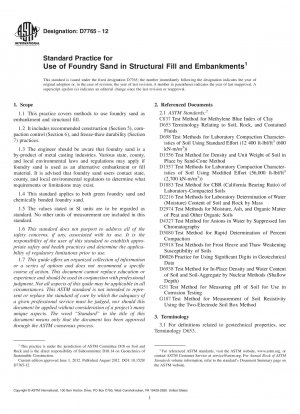ASTM D7765-12
Standard Practice for Use of Foundry Sand in Structural Fill and Embankments
- Standard No.
- ASTM D7765-12
- Release Date
- 2012
- Published By
- American Society for Testing and Materials (ASTM)
- Status
- Replace By
- ASTM D7765-18
- Latest
- ASTM D7765-18a
- Scope
- 1.1 Foundry sand should be conditioned for dust control and to prevent erosion by the addition of from 10 to 15 percent water by mass at the source site prior to delivery. This conditioning may include subsequent storage (stockpiling) of the foundry sand for a period of 24 hours or more, after the addition of water, until the water is evenly dispersed. If the supplier can demonstrate that water is evenly distributed throughout the foundry sand, then stockpiling may not be required.
4.1.3 Large-scale storage (stockpiling) of foundry sand at the site is permissible provided that the water content is maintained at 10 to 15 percent by mass for dust control.
4.1.4 Foundry sand material should be spread into loose lifts of approximately 20 centimeter (8-inch) thickness. The engineer may consider thicker lift dimensions if it can be satisfactorily demonstrated with a test section that adequate compaction can be achieved over the full depth of the thicker lift.
4.1.5 If necessary for proper compaction, water should be added to the foundry sand by the use of water distribution tank trucks. The water and foundry sand should be mixed using a rototilling mixer or other approved method. At the time of compaction, the foundry sand should have a moisture content that will result in an after compaction dry density that complies with the requirements of the project specifications. The dry density is a function of the clay content.
4.1.6 The first pass in the compaction process should be accomplished by the method known as tracking. This involves the use of a bulldozer track to accomplish initial compaction. The bulldozer is moved progressively across the foundry sand until the entire area is tracked.
4.1.7 The foundry sand should subsequently be compacted using pneumatic tired compaction equipment. Smooth steel drum and vibratory steel drum compactors are not as effective as pneumatic tired compactors for compacting foundry sand.
4.1.8 The foundry sand embankment should be compacted as required by the specifying agency. The dry density is a function of the clay content. Foundry sand with no clay should have a dry density equal to or greater than 1602 kg/m3 with an optimum water content of approximately 98201;%. Increasing clay content will increase dry density and optimum water content.
4.1.9 At the completion of each day???s work, the surface of the foundry sand embankment should be sealed. This means that it should be graded after compaction to the specification requirement and rolled with a smooth steel roller so that rain will flow off the foundry sand instead of puddling.
4.1.10 The contractor ...........
ASTM D7765-12 Referenced Document
- ASTM C837 Standard Test Method for Methylene Blue Index of Clay
- ASTM D1556 Standard Test Method for Density and Unit Weight of Soil in Place by the Sand-Cone Method
- ASTM D1557 Standard Test Methods for Laboratory Compaction Characteristics of Soil Using Modified Effort (56,000 ft-lbf/ft3 (2,700 kN-m/m3))
- ASTM D1883 Standard Test Method for CBR (California Bearing Ratio) of Laboratory-Compacted Soils
- ASTM D2216 Standard Test Method for Laboratory Determination of Water (Moisture) Content of Soil and Rock by Mass
- ASTM D2974 Standard Test Methods for Determining the Water (Moisture) Content, Ash Content, and Organic Material of Peat and Other Organic Soils
- ASTM D4327 Standard Test Method for Anions in Water by Chemically Suppressed Ion Chromatography
- ASTM D5080 Standard Test Method for Rapid Determination of Percent Compaction
- ASTM D5918 Standard Test Methods for Frost Heave and Thaw Weakening Susceptibility of Soils
- ASTM D6026 Standard Practice for Using Significant Digits in Geotechnical Data
- ASTM D653 Standard Terminology Relating to Soil, Rock, and Contained Fluids
- ASTM D6938 Standard Test Methods for In-Place Density and Water Content of Soil and Soil-Aggregate by Nuclear Methods (Shallow Depth)
- ASTM D698 Standard Test Methods for Laboratory Compaction Characteristics of Soil Using Standard Effort (12 400 ft-lbf/ft3 (600 kN-m/m3))
- ASTM G187 Standard Test Method for Measurement of Soil Resistivity Using the Two-Electrode Soil Box Method
- ASTM G51 Standard Test Method for Measuring pH of Soil for Use in Corrosion Testing
ASTM D7765-12 history
- 2018 ASTM D7765-18a Standard Practice for Use of Foundry Sand in Structural Fill and Embankments
- 2018 ASTM D7765-18 Standard Practice for Use of Foundry Sand in Structural Fill and Embankments
- 2012 ASTM D7765-12 Standard Practice for Use of Foundry Sand in Structural Fill and Embankments
